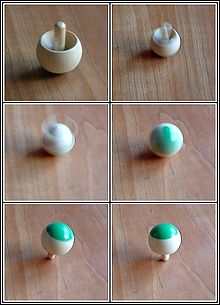Standing spinning top
A standing gyro (also turning gyro , reversing gyro ) is a gyro that rotates on a support surface perpendicular to the axis of rotation and stands up after being turned.
function
A standing up top behaves like a standing up man : The center of gravity is lower than the center of the curvature of the support surface. Without rotation, the gyroscope aligns itself under the influence of gravity so that the handle points upwards.
If the gyroscope is set in rotation, gravity tries to straighten it up again. It generates a torque that aligns the top in a precession motion perpendicular to the perturbation.
There is no fixed point around which the top rotates. Instead, it rolls on a circular line on the underside, the axis of rotation and axis of symmetry are offset. As a result, the friction of the gyroscope at the current pivot point generates a further downward torque, determined by the distance between the two axes. The top tilts steadily downwards until it finally turns to the other side.
Again, gravity creates torque, this time in the other direction. She tries to knock the top down. There is also no fixed pivot point on the top, even if the rolling surface is smaller than on the bottom. The torque generated by friction on the rolling line acts in the opposite direction and stabilizes a rotation in a position perpendicular to the support.
The direction of rotation is retained when viewed from outside the top (in the inertial system ), i.e. it is reversed for observers on the top. The rotation speed decreases because of the increase in the center of gravity and friction losses.
invention
The standing top was patented in 1891 by Helene Sperl from Munich as a "turning top". However, the phenomenon was known earlier. Long before that, children from the Amazon region had played with gourds made from calabashes that turned upside down. The patent expired in 1892 because the fees were not paid. In the 1930s, the painter Alfred Lomnitz held two patents for a turning top that he had developed. Another patent comes from Oskar Hummel from Stuttgart in 1953.
Web links
- A top that stands upside down , article by Wolfgang Bürger , In: Bild der Wissenschaft, issue 8/1998, page 92
- An Investigation Of The Tippe Top, by Antonis Vakis Detailed analysis and calculations (in English)
- Wendekreisel Website on wundersamessammelsurium.info with references to other patent specifications on the Wendekreisel
Patents
- Patent DE63261 : rate gyro . Registered on October 7, 1891 , published on July 12, 1892 , inventor: Helene Sperl.
- Patent DE613285 : Turning top , especially for play purposes. Registered on October 7, 1933 , published April 18, 1935 , inventor: Alfred Lomnitz .
- Patent GB442452 : A new spinning top, especially for toy purposes. Registered on August 23, 1934 , published February 10, 1936 , inventor: Alfred Lomnitz.
- Patent DE811096 : gyroscope. Registered on October 2, 1948 , published June 14, 1951 , inventor: Oscar Hummel.
- Patent DE889574 : Gyro with drive pin , which changes its starting position and reverses under the action of the rotational movement communicated to its approximately hollow spherical body. Registered on October 22, 1949 , published on December 24, 1952 , inventor: Oskar Hummel.
Individual evidence
- ↑ Friedhelm Kuypers: Classical Mechanics: With over 300 examples and exercises with solutions , Wiley-VCH, 2008, p. 219: Online at Google Books ( Memento of the original from October 30, 2013 in the Internet Archive ) Info: The archive link became automatic used and not yet tested. Please check the original and archive link according to the instructions and then remove this notice.
- ↑ Friedhelm Kuypers, Christian Ucke: Stand on top! (PDF; 914 kB) . In: Physics in Our Time , Volume 25, September 1994, Issue 5/94, p. 214 f.
- ↑ see article A top that is upside down on the web links


